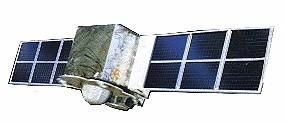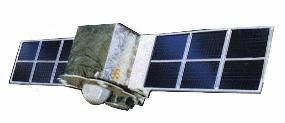
Home - Search - Browse - Alphabetic Index: 0- 1- 2- 3- 4- 5- 6- 7- 8- 9
A- B- C- D- E- F- G- H- I- J- K- L- M- N- O- P- Q- R- S- T- U- V- W- X- Y- Z
FY-1
 Fengyun |
AKA: Feng Yun. Status: Operational 1988. First Launch: 1988-09-06. Last Launch: 2002-05-15. Number: 4 . Gross mass: 880 kg (1,940 lb). Height: 1.20 m (3.90 ft). Span: 1.20 m (3.90 ft).
The major payload was a scanning radiometer with five observation bands in the visible and near infra-red spectra.
The satellite was three-axis stabilized, and employed an X-band data transmitter. Design life was one year. The spacecraft were designed to be comparable to existing international low earth orbit meteorological and remote sensing systems, including APT transmissions in the 137 MHz band. The satellite structure and support systems were created by the Shanghai Satellite Engineering and Research Centre of the China Space Technology Institute. The payload was developed by the Shanghai Technical Physics Institute of the Chinese Academy of Sciences. The first two satellites were experimental test systems launched prior to the operational version. They were similar in design, although technical characteristics differed. The height of the 1.4 m x 1.4 m box-shaped spacecraft bus of Feng Yun 1A was increased from 1.2 m to nearly 1.8 m for Feng Yun 1B. Total spacecraft mass increased from 750 kg to about 880 kg. Both satellites were powered by two solar arrays (about 3.5 m long each) with a combined rating of more than 800 W. Nickel-cadmium batteries were used for electrical power storage. Attitude control was maintained by a combination of nitrogen cold gas thrusters and reaction wheels, although both spacecraft suffered serious malfunctions in this system.
Feng Yun 1A was lost after only 38 days, but Feng Yun 1B operated for more than a year. The Feng Yun 1 primary payload consisted of two Very High Resolution Scanning Radiometers (VHRSR) with a combined mass of 95 kg. These optical-mechanical scanners operated at 360 rpm with a 20-cm diameter primary mirror in five spectral bands. The system swath was 2,860 km with a 1.08 km resolution in the High Resolution Picture Transmission (HRPT) mode and 4-km resolution in the Automatic Picture Transmission (APT) mode. The first improved Feng Yun 1C spacecraft was launched in 1999. It carried a 10-channel scanning radiometer with a resolution equal to that of Feng Yun 1A and B. After several years it was announced that China planned to put six meteorological satellites into orbit from 2002 to 2008 to offer comprehensive weather services for the 2008 Olympic Games. This would include Feng Yun 1D to be launched into space by a Long March 4 launch vehicle in June 2002.
More at: FY-1.
Family: Earth, Earth weathersat, Sun synchronous orbit, Technology. Country: China. Launch Vehicles: Chang Zheng 4, Chang Zheng 4B. Launch Sites: Taiyuan, Taiyuan LC1. Agency: MAI, CASC, SSERC. Bibliography: 119, 2, 424, 532, 534, 552, 554, 6, 12464.
 | FY-1 |
 | FY-1A Credit: Manufacturer Image |
 | FY-1 Credit: via Chen Lan |
1988 September 6 - . 20:30 GMT - . Launch Site: Taiyuan. Launch Complex: Taiyuan LC1. LV Family: CZ. Launch Vehicle: Chang Zheng 4.
- FY-1A - . Payload: Feng Yun 1A. Mass: 750 kg (1,650 lb). Nation: China. Agency: MAI. Class: Technology. Type: Weather technology satellite. Spacecraft: FY-1. USAF Sat Cat: 19467 . COSPAR: 1988-080A. Apogee: 895 km (556 mi). Perigee: 875 km (543 mi). Inclination: 98.80 deg. Period: 102.70 min. Experimental weather satellite. First use of new launch site and launch vehicle. Failed after 38 days due to problems with attitude control system..
1990 September 3 - . 00:53 GMT - . Launch Site: Taiyuan. Launch Complex: Taiyuan LC1. LV Family: CZ. Launch Vehicle: Chang Zheng 4.
- FY-1B - . Payload: Feng Yun 1B. Mass: 881 kg (1,942 lb). Nation: China. Agency: MAI. Class: Technology. Type: Weather technology satellite. Spacecraft: FY-1. USAF Sat Cat: 20788 . COSPAR: 1990-081A. Apogee: 897 km (557 mi). Perigee: 875 km (543 mi). Inclination: 98.80 deg. Period: 102.70 min. Experimental weather satellite. Operated for over a year..
1999 May 10 - . 01:33 GMT - . Launch Site: Taiyuan. Launch Complex: Taiyuan LC1. LV Family: CZ. Launch Vehicle: Chang Zheng 4B.
- FY-1C - . Payload: Feng Yun 1C. Mass: 900 kg (1,980 lb). Nation: China. Agency: CASC. Manufacturer: Shanghai Institute of Satellite Engineering. Class: Earth. Type: Weather satellite. Spacecraft: FY-1. USAF Sat Cat: 25730 . COSPAR: 1999-025A. Apogee: 880 km (540 mi). Perigee: 846 km (525 mi). Inclination: 98.80 deg. Period: 102.20 min. Operational weather satellite. First launch of stretched CZ-4B booster. After retirement the satellite was destroyed in the first test of the Chinese ASAT weapon on 11 January 2007..
2002 May 15 - . 01:50 GMT - . Launch Site: Taiyuan. Launch Complex: Taiyuan LC1. LV Family: CZ. Launch Vehicle: Chang Zheng 4B.
- FY-1D - .
Mass: 960 kg (2,110 lb). Nation: China.
Agency: CASC.
Class: Earth.
Type: Weather satellite. Spacecraft: FY-1.
USAF Sat Cat: 27431 . COSPAR: 2002-024B. Apogee: 873 km (542 mi). Perigee: 850 km (520 mi). Inclination: 98.70 deg. Period: 102.20 min.
The second stage separated six minutes after launch, putting the stack on a suborbital trajectory. After a brief coast up to 860 km the third stage fired at around 0200 UTC to circularize the orbit. FY-1D, a 950 kg weather satellite with a 10-channel radiometer, separated from the stack followed by a small adapter. The final stage was left in a slightly lower 812 x 883 km orbit.
Back to top of page
Home - Search - Browse - Alphabetic Index: 0- 1- 2- 3- 4- 5- 6- 7- 8- 9
A- B- C- D- E- F- G- H- I- J- K- L- M- N- O- P- Q- R- S- T- U- V- W- X- Y- Z
© 1997-2019 Mark Wade - Contact
© / Conditions for Use